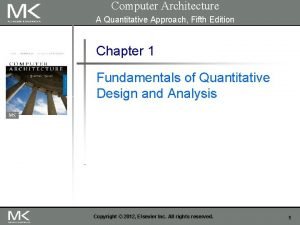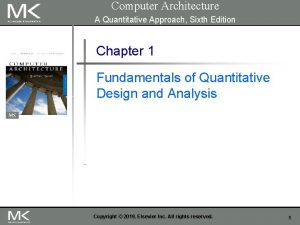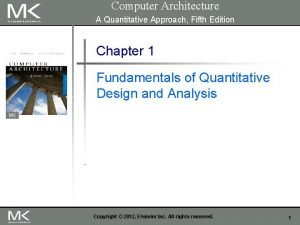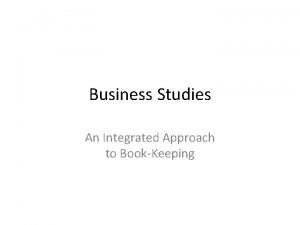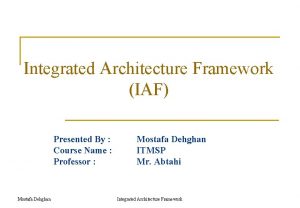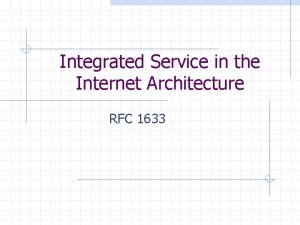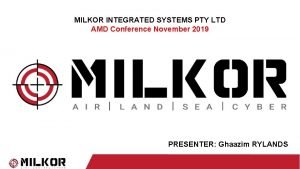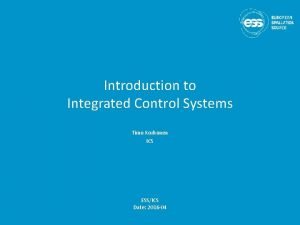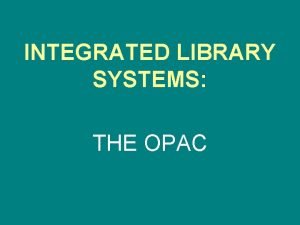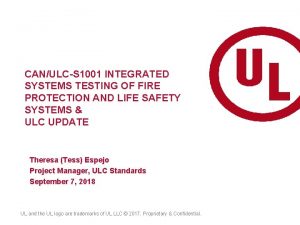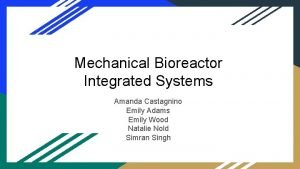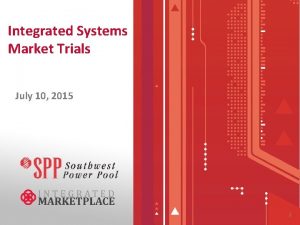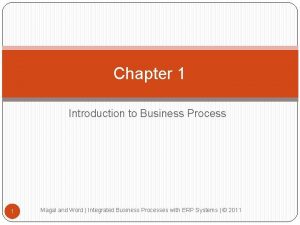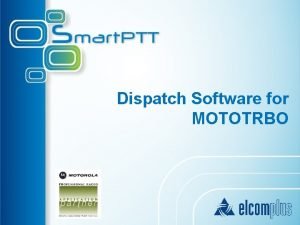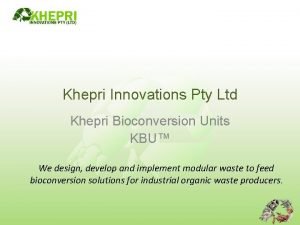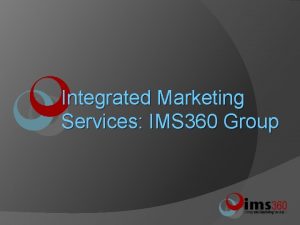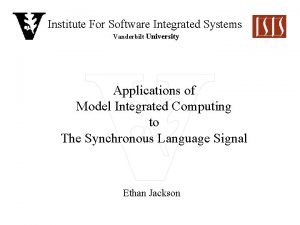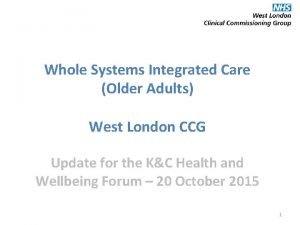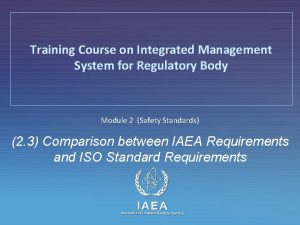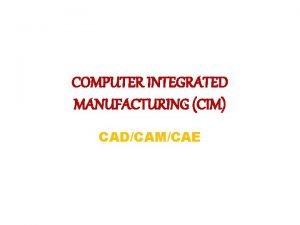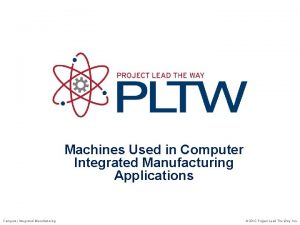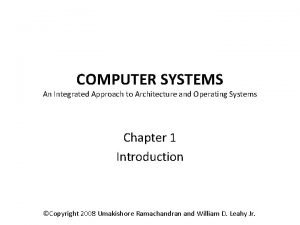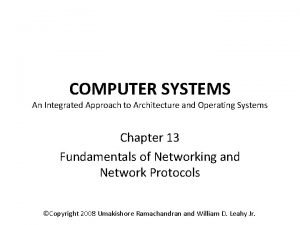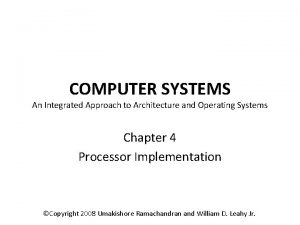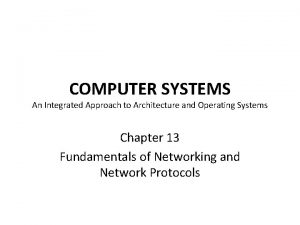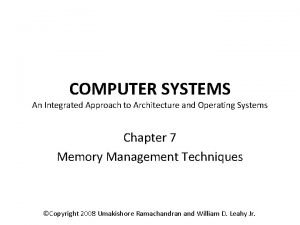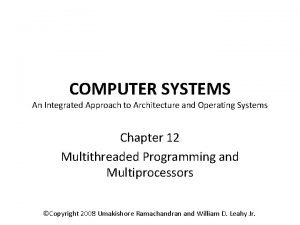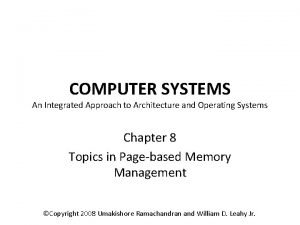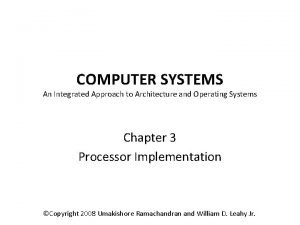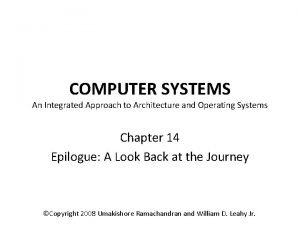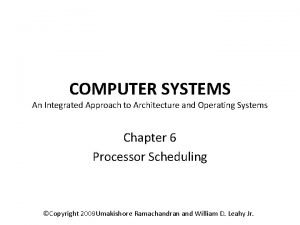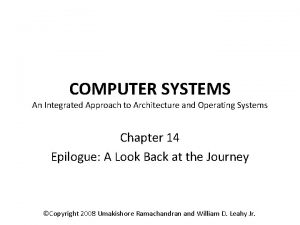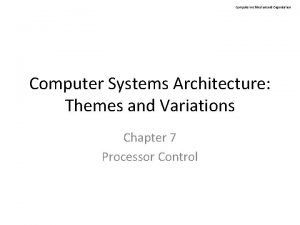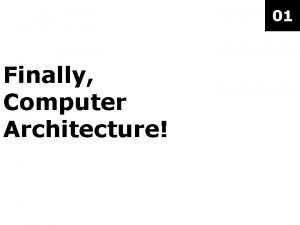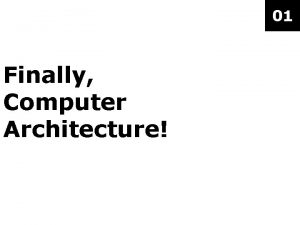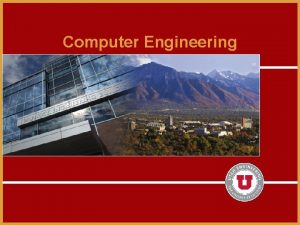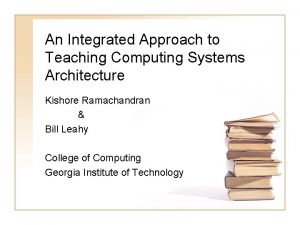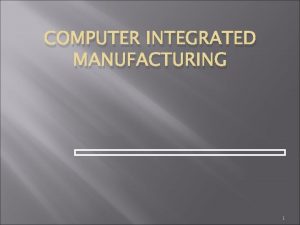COMPUTER SYSTEMS An Integrated Approach to Architecture and


































- Slides: 34

COMPUTER SYSTEMS An Integrated Approach to Architecture and Operating Systems Chapter 10 Input/Output and Stable Storage ©Copyright 2008 Umakishore Ramachandran and William D. Leahy Jr.

10. 1 Communication between the CPU and the I/O devices Computer Device Controller Input/Output Device

10. 1. 1 Device controller

10. 1. 2 Memory Mapped I/O CPU Address Data 7 0 Main memory Data register (address = 5000) 7 Ready 0 IF … IE Status register (address = 5002) Keyboard controller

10. 2 Programmed I/O

10. 3 DMA CPU Memory bus DMA controller Status Go Command Memory Device address Memory buffer address Count 256 bytes Buffer

10. 4 Buses • System Bus (or Memory Bus) is key resource in entire design. • Functionally, bus has following components: – Address lines – Data lines – Command lines – Interrupt acknowledge lines – Bus arbitration lines

10. 4 Buses CPU System bus Bridge Memory PCI bus Controller

10. 5 I/O Processor CPU I/O processor System bus Bridge I/O bus Shared Memory Controller

10. 6 Device Driver

10. 6. 1 An Example Command pan(±ɵ) tilt(±ɵ) zoom(±z) Start Stop memory buffer(M) number of frames (N) enable interrupt disable interrupt start DMA Controller Action Pan the camera view by ±ɵ Tilt camera position by ±ɵ Zoom camera focus by ±z Start camera Stop camera Set memory buffer address for data transfer to M Set number of frames to be captured and transferred to memory to N Enable interrupt from the device Disable interrupt from the device Start DMA data transfer from camera

10. 6. 1 An Example // device driver: camera // The device driver performs several functions: // control_camera_position; // convey_DMA_parameters; // start/stop data transfer; // interrupt_handler; // error handling and reporting; // Control camera position camera_position_control (angle pan_angle; angle tilt_angle; int z) { pan(pan_angle); tilt(tilt_angle); zoom(z); } // Set up DMA parameters for data transfer camera_DMA_parameters(address mem_buffer; int num_frames) { memory_buffer(mem_buffer); capture_frames(num_frames); }

10. 6. 1 An Example // Start DMA transfer camera_start_data_transfer() { start_camera(); start_DMA(); } // Stop DMA transfer camera_stop_data_transfer() { // automatically aborts data transfer // if camera is stopped; stop_camera(); } // Enable interrupts from the device camera_enable_interrupt() { enable_interrupt(); } // Disable interrupts from the device camera_disable_interrupt() { disable_interrupt(); }

10. 6. 1 An Example // Device interrupt handler camera_interrupt_handler() { // This will be coded similar to any // interrupt handler we have seen in // chapter 4. // // The upshot of interrupt handling may // to deliver “events” to the upper layers // of the system software (see Figure 10. 9) // which may be one of the following: // - normal I/O request completion // - device errors for the I/O request // }

10. 7 Peripheral Devices Device Input/output Human in the loop Yes No No Data rate (circa 2008) 5 -10 bytes/sec 80 -200 bytes/sec 200 -350 MB/sec 100 -200 MB/sec PIO DMA Keyboard Mouse Graphics display Disk (hard drive) Input Output Input/Output X X Network (LAN) Input/Output No 1 Gbit/sec X Modem Input/Output No 1 -8 Mbit/sec X Inkjet printer Laser printer Voice (microphone/speaker) Audio (music) Flash memory Output Input/Output No No Yes 20 -40 KB/sec 200 -400 KB/sec 10 bytes/sec Output Input/Output No No 4 -500 KB/sec 10 -50 MB/sec X X CD-RW Input/Output No 10 -20 MB/sec X DVD-R Input No 10 -20 MB/sec X X X X

10. 8 Disk Storage Shaft Head Track Spindle Sector Arm Head Assembly All heads move together Platter Top and bottom Surfaces

10. 8 Disk Storage Each circle represents two tracks: one for top surface and one for bottom surface Cylinder X: Track X from all 12 surfaces (2 per platter)

10. 8 Disk Storage (a) Normal (Non zoned) recording (b) Zoned recording

10. 8. 1 Saga of Disk Technology Disk recording: (a) Longitudinal recording; (b) PMR

10. 9 Disk Scheduling Algorithms Name Notation Units Throughput n/T Jobs/sec System-centric metric quantifying the number of I/O requests n executed in time interval T Avg. Turnaround time (tavg) (t 1+t 2+…+tn)/n Seconds System-centric metric quantifying the average time it takes for a job to complete Avg. Waiting time (wavg) ((t 1 -e 1) + (t 2 -e 2)+ … + (tn-en))/n or (w 1+w 2+ … +wn)/n Seconds System-centric metric quantifying the average waiting time that an I/O request experiences ti Seconds User-centric metric quantifying the turnaround time for a specific I/O request i Response time/ turnaround time Description Name Notation Variance in E[(ti – tavg)2] Response time Variance in Wait time E[(wi – wavg)2] Starvation - Units Description Seconds User-centric metric 2 that quantifies the statistical variance of the actual response time (ti) experienced by an I/O request i from the expected value (tavg) Seconds User-centric metric 2 that quantifies the statistical variance of the actual wait time (wi) experienced by an I/O request i from the expected value (wavg) User-centric qualitative metric that signifies denial of service to a particular I/O request or a set of I/O request due to some intrinsic property of the I/O scheduler

Assumptions for Disk Scheduling Algorithms • Disk has 200 tracks numbered 0 to 199 – (with 0 being outermost and 199 being innermost). • Head when in its fully retracted position is on track 0. • Head assembly extends to its maximum span from its resting position when it is on track 199.

10. 9. 1 First-Come First Served t 3 t 1 head t 4 t 2

10. 9. 2 Shortest Seek Time First t 3 t 1 head t 4 t 2

10. 9. 3 Scan (elevator algorithm) Outermost track head t 3 Innermost track t 4 t 1 t 6 t 5 t 2

10. 9. 4 C-Scan (Circular Scan) Outermost track Innermost track head t 3 t 4 t 1 Retract t 6 t 5 t 2

10. 9. 5 Look and C-Look

10. 9. 6 Disk Scheduling Summary • Choice of scheduling algorithm depends on a number of factors including expected layout, storage allocation policy, and electromechanical capabilities of disk drive. • Typically, some variant of LOOK or C-LOOK is used for disk scheduling. We covered other algorithms more from the point of completeness than as viable choices for implementation in a real system.

10. 9. 7 Comparison of the Algorithms Requests Response time FCFS SSFT R 1 (cyl 20) R 2 (cyl 17) R 3 (cyl 55) R 4 (cyl 35) R 5 (cyl 25) R 6 (cyl 78) R 7 (cyl 99) Average 3 6 44 64 74 127 148 66. 4 7 10 48 28 2 71 92 36 LOOK 155 158 32 12 2 55 76 70

10. 10 Solid State Drive

10. 11 Evolution of I/O Buses and Device Drivers • • • Plug and Play (Solves 3 rd party problem) Parallel Buses (e. g. PCI) Serial Buses – USB (Microsoft/Intel) • USB 1. 0: 1. 5 Mb/s • USB 2. 0: 60 Mb/s – Firewire (Apple) • 100 Mb/s – Why serial? • • • Smaller Cheaper No cross-talk Serial signaling can be operated faster than parallel (Higher frequencies) Graphics Connections (connecting 3 -D graphics controller card to motherboard) – Advanced Graphics Port (AGP) – PCI Express (PCI-e)

10. 11. 1 Dynamic Loading of Device Drivers • Device drivers can be Plug and Play • New device is connected, generates interrupt • OS looks through its list of device drivers and finds correct one* • Dynamically Loads and links driver into memory *If no driver found has to request user supply driver

10. 11. 2 Putting it all Together

10. 11. 2 Putting it all Together

10. 12 Summary • Mechanisms for communication between processor and I/O devices including programmed I/O and DMA. • Device controllers and device drivers. • Buses in general and evolution of I/O buses in particular, found in modern computer systems. • Disk storage and disk-scheduling algorithms.
 Product architecture example
Product architecture example Modular and integral architecture
Modular and integral architecture Computer architecture a quantitative approach 5th edition
Computer architecture a quantitative approach 5th edition Computer architecture a quantitative approach
Computer architecture a quantitative approach Computer architecture a quantitative approach sixth edition
Computer architecture a quantitative approach sixth edition Computer architecture a quantitative approach
Computer architecture a quantitative approach Computer architecture a quantitative approach 6th
Computer architecture a quantitative approach 6th Computer architecture a quantitative approach sixth edition
Computer architecture a quantitative approach sixth edition Difference between computer architecture and organisation
Difference between computer architecture and organisation Three bus architecture
Three bus architecture What is basic computer organization
What is basic computer organization An integrated approach to business studies
An integrated approach to business studies Integrated and differentiated services in computer networks
Integrated and differentiated services in computer networks Difference between virtual and datagram circuit
Difference between virtual and datagram circuit Tony wagner's seven survival skills
Tony wagner's seven survival skills Iaf capgemini
Iaf capgemini Iaf architecture
Iaf architecture Integrated services architecture
Integrated services architecture Milkor centurion
Milkor centurion Integrated control and safety system
Integrated control and safety system Opacdr
Opacdr Ulc s1001 certification
Ulc s1001 certification Adams integrated systems
Adams integrated systems Damkt
Damkt Construct an integrated business process
Construct an integrated business process Integrated dispatch systems
Integrated dispatch systems Milkor integrated systems cape town
Milkor integrated systems cape town Ims map 360
Ims map 360 Institute for software integrated systems
Institute for software integrated systems Whole systems integrated care
Whole systems integrated care Gsr part 2
Gsr part 2 Modern systems analysis and design
Modern systems analysis and design A modern approach to systems analysis and design
A modern approach to systems analysis and design Cim wheel starts from
Cim wheel starts from Computer integrated manufacturing applications
Computer integrated manufacturing applications


